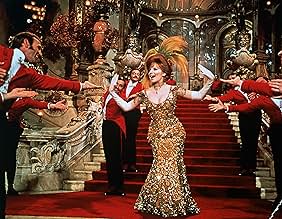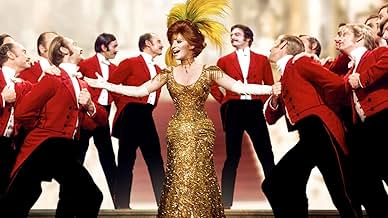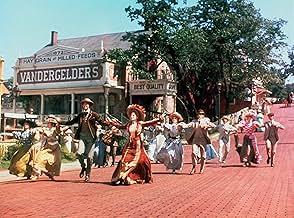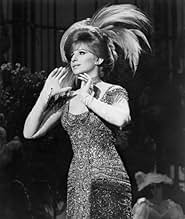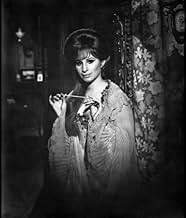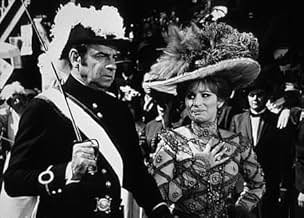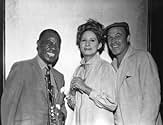La marieuse Dolly Levi se rend à Yonkers pour trouver un partenaire pour le millionnaire Horace Vandergelder, convaincre sa nièce, le fiancé de sa nièce et ses deux assistants de se rendre à... Tout lireLa marieuse Dolly Levi se rend à Yonkers pour trouver un partenaire pour le millionnaire Horace Vandergelder, convaincre sa nièce, le fiancé de sa nièce et ses deux assistants de se rendre à New York en cours de chemin.La marieuse Dolly Levi se rend à Yonkers pour trouver un partenaire pour le millionnaire Horace Vandergelder, convaincre sa nièce, le fiancé de sa nièce et ses deux assistants de se rendre à New York en cours de chemin.
- A remporté 3 oscars
- 4 victoires et 13 nominations au total
- Laborer
- (uncredited)
- Paper Ricker
- (uncredited)
- …
- Townsperson
- (uncredited)
- Dancer
- (uncredited)
- …
Avis en vedette
"Hello, Dolly!" deserved the Oscars it won, such as musical direction, sound, and art direction-set design. About 15 years ago I stopped in the riverside village of Garrison, New York, to see where it was partially filmed. The real building that was adapted into Vandergelder's Hay & Feed was still there at the time, and "Vandergelder" was etched on the window pane from its use in the film. The bridge over the railway tracks is still there.
As much as I like the film as a whole, it does have some problems that could have been easily corrected. The early scene with Walter Matthau and Tommy Tune arguing over Ermengarde is overly dramatic and simply too theatrical. It might have been fine on Broadway, but the genre of cinema requires a bit of toning down. I blame this purely on Gene Kelly, the director, who should have known better. He is the one who is supposed to sense the pacing and delivery of lines. I get the impression he was trying to speed things up, knowing that there is a lot to fit into the picture. The screenplay was naturally required to closely follow the original material, but it could have been simplified a bit without sacrificing anything important. An example of this is the endless number of times that the audience is reminded that the main characters are going "to New York" by train. Once was enough.
Still, the music and choreography are superb, and carry the picture. Not everyone in it can sing as beautifully as Barbra Streisand, but it succeeds nonetheless. The number "Put On Your Sunday Clothes" is one of Hollywood's golden moments in terms of production quality. I have seen Carol Channing do the stage version and she was great, but I also feel that Barbra Streisand was perfectly adequate here. She can sing better than Ms. Channing and has real star quality.
If you visit the interesting Hudson River area of New York state, you will be warmly reminded of the scenic beauty in "Hello, Dolly!" Drop by the U.S. Military Academy at West Point to take the public tour and you will see the magnificent setting where the final wedding scene was done, minus the church of course.
My favorite part of the movie, and the heart of the film, is the "courtship" of Cornelius & Irene and Barnaby & Minnie Fay. Michael Crawford and the late Danny Lockin are absolutely adorable as Cornelius and Barnaby. The "Dancing" and "Elegance" numbers and the dinner scene at the Harmonia Gardens are worth the price of admission alone. Barbra plays better with the rest of the cast too; she's more believable as a "woman of the world" when she's with the younger cast members. The production design is wonderful as well. While the movie was outrageously expensive for its time, just about every dollar is visible on screen. The claustrophobic musicals they've made since the Seventies really look deficient when compared to the wide-open dance scenes and crowd shots in classic musicals like this one.
All in all, Hello, Dolly has much to offer. It's not the best musical ever made by a long shot, but it's undeniably fun to watch. It would be fun to see Barbra play the role now that she's a more appropriate age for it. Unfortunately, she doesn't do musicals anymore. Maybe Tyne Daly would take the part.
The story line is familiar. The musical is based on Thornton Wilder's play THE MATCHMAKER and was a Broadway sensation for Carol Channing in 1964. This film version trims the story, drops a couple songs, and adds a new one ("Love Is Only Love"). Directed by Gene Kelly and choreographed by Michael Kidd, the film makes good use of location shooting around New York State.
Streisand, in only her second film, is in great voice and shows a nice comic touch. Yes, Dolly is supposed to be "middle aged," but it really doesn't matter. And with those turn-of-the-century hair styles and clothes, you can't tell anyway.
Walter Matthau is good as crusty Horace (though his accent wanders) and Michael Crawford makes for a delightful Cornelius Hackl. Marianne McAndrew is Irene, E.J. Peaker is Minnie, and Danny Lockin is Barnaby. Others in the cast include Judy Knaiz as Gussie, Tommy Tune as Ambrose, Joyce Ames as Ermengarde, David Hurst as Rudy, and Louis Armstrong as the bandleader.
The songs by Jerry Herman are wonderful and have witty lyrics. Two huge production numbers dominate the film. In the first half, "Before the Parade Passes By" is a stunner, sung by Streisand, it turns into a gigantic parade beneath a summer sky and it's as big and brassy a musical number as you'll ever see.
Of course the title song is a show stopper and well staged in the Harmonia Gardens on 14th Street. Streisand makes her famous entrance (and return to life after a period of widowhood) down a grand staircase. She wears a glittering gown of gold as she sings and dances with a battery of waiters. She also does a memorable duet with Armstrong (in his final film appearance).
Yes, it's old fashioned. But the film is so bright and tuneful, it never lags. It was the #4 box-office hit of 1969.
Bottom line: Streisand makes for a great Dolly, and this is a great film musical.
Le saviez-vous
- AnecdotesAccording to Michael Crawford, he auditioned for Gene Kelly in his hotel room. Kelly asked him if he knew any tap steps, and tried to coach him on some on top of the coffee table. Crawford tried to imitate him, but was so nervous at the idea of dancing with the famous dancer and choreographer that he kept messing up. He was convinced he'd failed the audition, when Kelly told him "What we're looking for is an attractive idiot: My wife thinks you're attractive, and I think you're an idiot!", telling him he'd gotten the part.
- GaffesDuring opening credits, as Walter Matthau's name appears, a couple of wrecked modern automobiles (circa 1960s) can be seen dumped in foliage to right of railroad track.
- Citations
Dolly Levi: Money, pardon the expression, is like manure. It's not worth a thing unless it's spread around, encouraging young things to grow.
- Autres versionsThere are two alternate takes during the number Before The Parade Passes By. They occur as Dolly Levi (played by Barbra Streisand) is running down the garden path to see the parade and is singing the line "Before the Parade Passes by".In the 35mm prints which were sent to movie theaters after the roadshow engagements, Dolly almost loses her hat while running. This was used for the home video version. The 70mm prints have a different take, in which Dolly did not have any hat problems. This was used for the DVD version.
- ConnexionsEdited into American Masters: Gene Kelly: Anatomy of a Dancer (2002)
- Bandes originalesJust Leave Everything To Me
(1964) (uncredited)
Written by Jerry Herman
Performed by Barbra Streisand and Chorus
Meilleurs choix
- How long is Hello, Dolly!?Propulsé par Alexa
Détails
- Date de sortie
- Pays d’origine
- Langue
- Aussi connu sous le nom de
- Hello, Dolly!
- Lieux de tournage
- sociétés de production
- Consultez plus de crédits d'entreprise sur IMDbPro
Box-office
- Budget
- 25 000 000 $ US (estimation)
- Brut – États-Unis et Canada
- 400 881 $ US
- Fin de semaine d'ouverture – États-Unis et Canada
- 221 204 $ US
- 11 août 2019
- Brut – à l'échelle mondiale
- 403 127 $ US
- Durée2 heures 26 minutes
- Couleur
Contribuer à cette page



